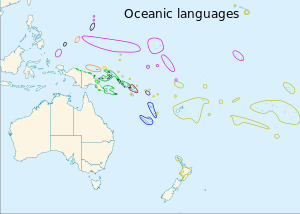
The approximately 450 Oceanic languages are a branch of the Austronesian languages. The area occupied by speakers of these languages includes Polynesia, as well as much of Melanesia and Micronesia. Though covering a vast area, Oceanic languages are spoken by only two million people. The largest individual Oceanic languages are Eastern Fijian with over 600,000 speakers, and Samoan with an estimated 400,000 speakers. The Gilbertese (Kiribati), Tongan, Tahitian, Māori and Tolai languages each have over 100,000 speakers. The common ancestor which is reconstructed for this group of languages is called Proto-Oceanic.

The over 200 Central–Eastern Oceanic languages form a branch of the Oceanic language family within the Austronesian languages.
Gela, also known as Nggela and formerly as Florida, is an Oceanic language spoken in the Nggela Islands, in the middle of the Solomon Islands. It belongs to the Southeast Solomonic group of the Oceanic family.

The Admiralty Islands languages are a group of some thirty Oceanic languages spoken on the Admiralty Islands. They may include Yapese, which has proven difficult to classify.
The nine South Vanuatu languages form a family of the Southern Oceanic languages, spoken in Tafea Province of Vanuatu.

The Western Oceanic languages is a linkage of Oceanic languages, proposed and studied by Ross (1988). They make up a majority of the Austronesian languages spoken in New Guinea.

The twenty Micronesian languages form a family of Oceanic languages. Micronesian languages are known for their lack of plain labial consonants; they have instead two series, palatalized and labio-velarized labials, similar to the related Loyalty Islands languages.
The Meso-Melanesian languages are a linkage of Oceanic languages spoken in the large Melanesian islands of New Ireland and the Solomon Islands east of New Guinea. Bali is one of the most conservative languages.
The Manus languages are a subgroup of about two dozen Oceanic languages located on Manus Island and nearby offshore islands in Manus Province of Papua New Guinea. The exact number of languages is difficult to determine because they form a dialect continuum. The name Manus originally designated an ethnic group whose members spoke closely related languages and whose coastal dwellers tended to build their houses on stilts out over the sea.

Chuukic, historically also rendered as Trukic, is a subgroup of the Chuukic–Pohnpeic family of the Austronesian language family. The languages are primarily spoken in Chuuk State and Yap State of the Federated States of Micronesia, as well as in the outer islands of Palau. The Carolinians of the Commonwealth of the Northern Mariana Islands also speak their own language distinct from the historically native Chamorro people.
The Sarmi-Jayapura Bay languages consist of half a dozen languages spoken on the northern coast of Papua province of Indonesia:
The Huon Gulf languages are Western Oceanic languages spoken primarily in Morobe Province of Papua New Guinea. They may form a group of the North New Guinea languages, perhaps within the Ngero–Vitiaz branch of that family.
Lungalunga, frequently though ambiguously called Minigir, is spoken by a small number of the Tolai people of Papua New Guinea, who live on the Gazelle Peninsula in East New Britain Province. It is often referred to in the linguistics literature as the Tolai "dialect" with an.

The Southern Oceanic languages are a linkage of Oceanic languages spoken in Vanuatu and New Caledonia. It was proposed by John Lynch in 1995 and supported by later studies. It appears to be a linkage rather than a language family with a clearly defined internal nested structure.
Vitu or Muduapa is an Oceanic language spoken by about 7,000 people on the islands northwest of the coast of West New Britain in Papua New Guinea.
ꞌAreꞌare is the name of a people from the south of the island of Malaita, which is part of the Solomon Islands. Their language is the ꞌAreꞌare language, which is part of the Austronesian language family. In 1999 there were an estimated 18,000 speakers, up from about 8-9,000 in the 1970s.
Proto-Oceanic is a proto-language that historical linguists since Otto Dempwolff have reconstructed as the hypothetical common ancestor of the Oceanic subgroup of the Austronesian language family. Proto-Oceanic is a descendant of the Proto-Austronesian language (PAN), the common ancestor of the Austronesian languages.
Arosi is a Southeast Solomonic language spoken on the island of Makira. Arosi is primarily spoken by inhabitants who live to the west of the Wango River on Makira. Makira is in the easternmost part of the Solomon Islands. Makira was visited and named by Álvaro de Mendaña de Neira in 1588. Upon landing on Makira, the Spanish were the first to record Arosi, but only six words were initially recorded. Arosi is one of the lesser known languages in Melanesia.
The family of Northwest Solomonic languages is a branch of the Oceanic languages. It includes the Austronesian languages of Bougainville and Buka in Papua New Guinea, and of Choiseul, New Georgia, and Santa Isabel in Solomon Islands.
The Chuukic–Pohnpeic or historically Trukic-Ponapeic languages are a family of Micronesian languages consisting of two dialect continua, Chuukic and Pohnpeic. They are the westernmost and historically most recent Micronesian languages.



